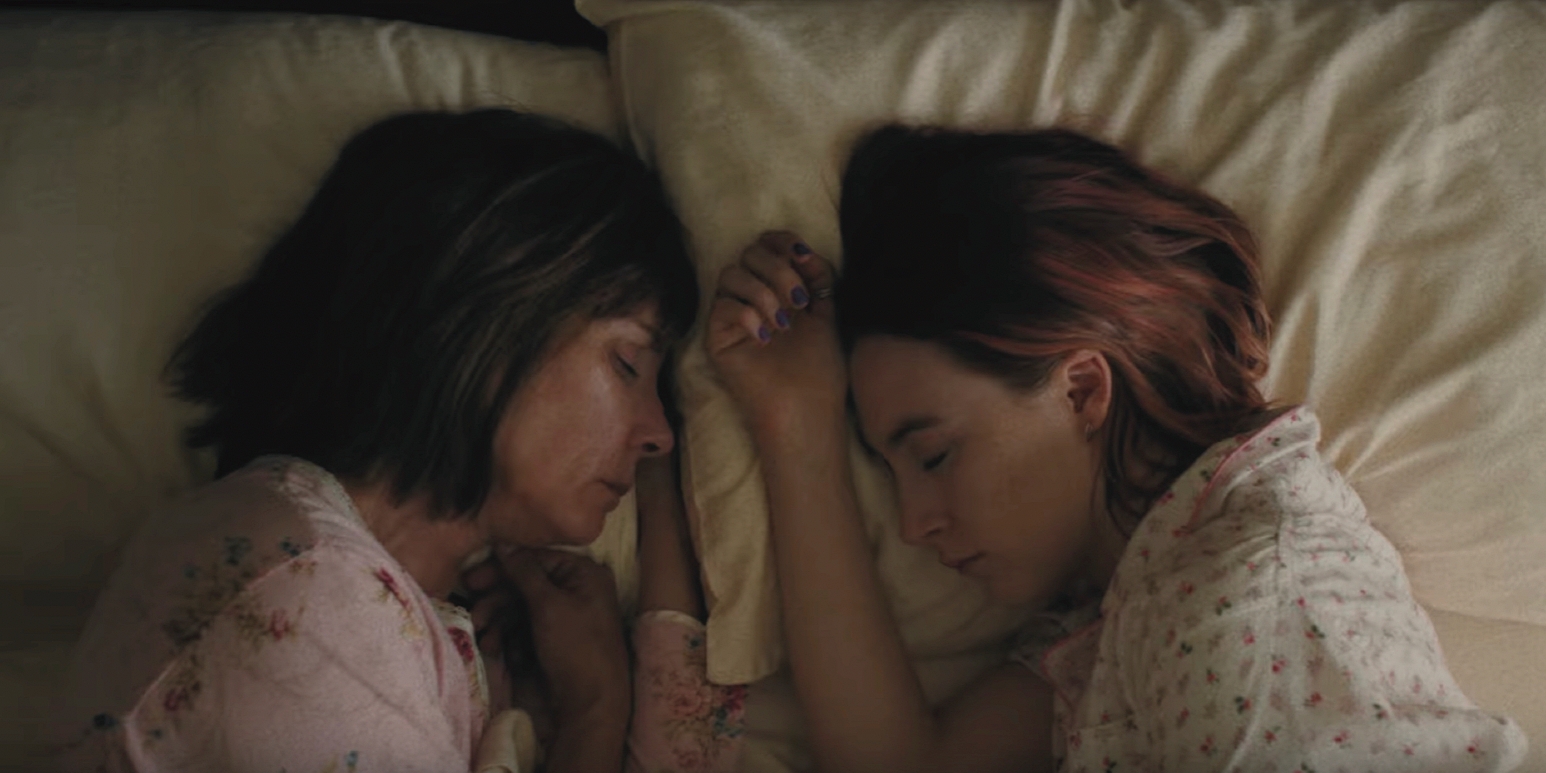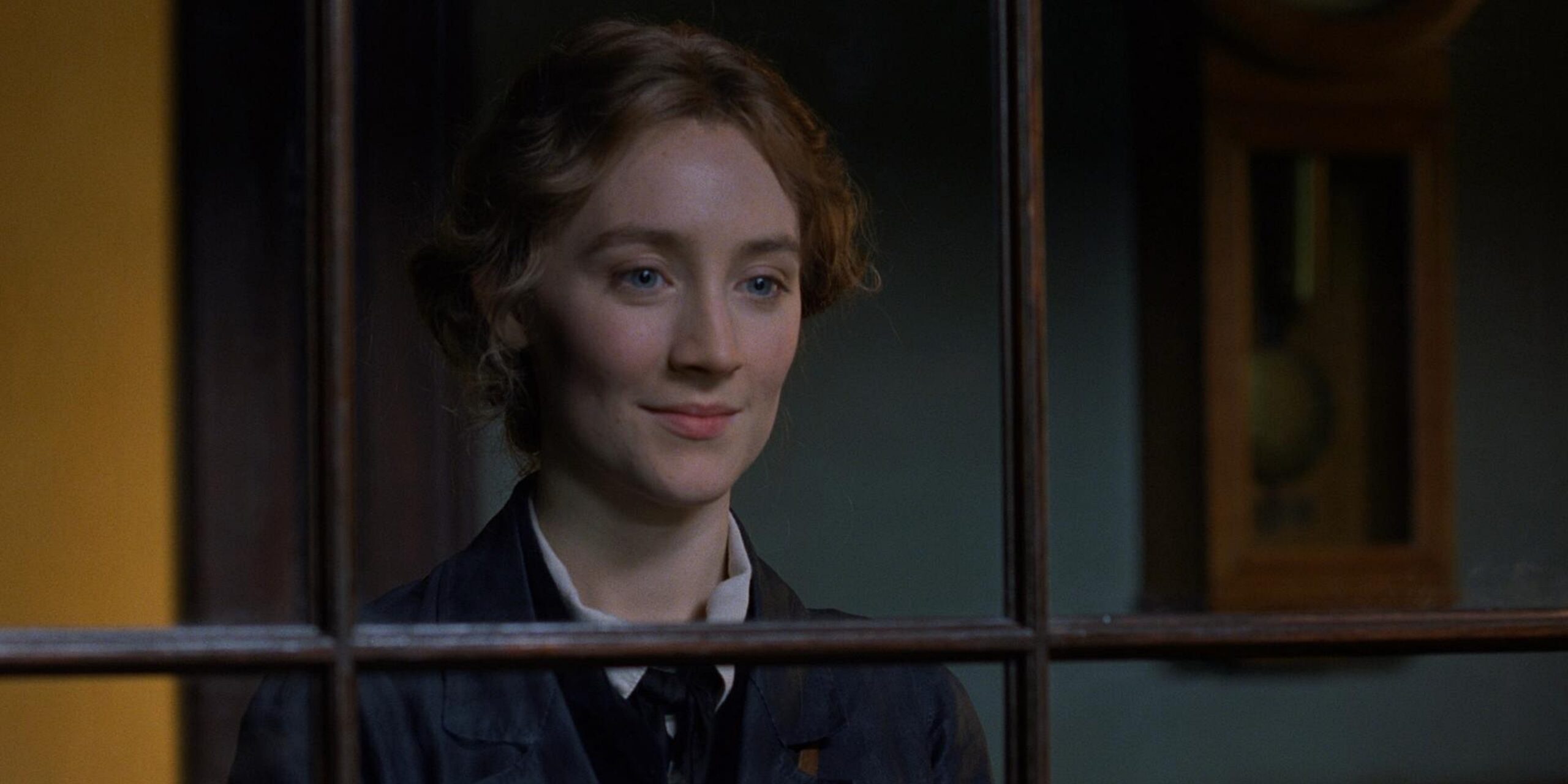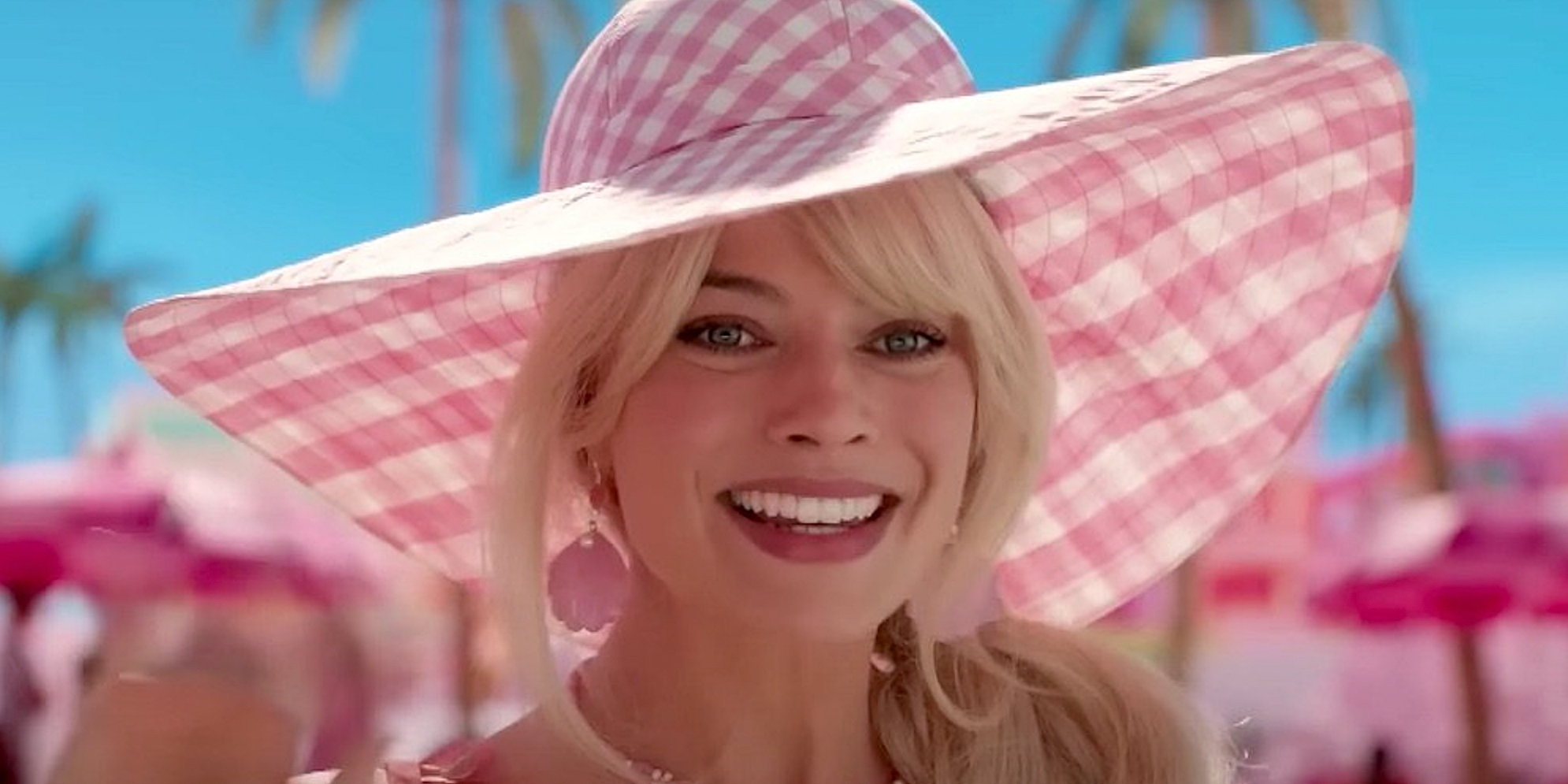The opening three films of Greta Gerwig’s solo directing career present vastly different styles, which only highlight what a special filmmaker she has become in such a short amount of time. Her solo directorial debut, “Lady Bird,” shows a rebellious teen wanting to leave her hometown of Sacramento in a grounded family dramedy set in the early noughties, matched with neutral colors and aesthetics. Then came “Little Women” in 2019, a new adaptation of the 19th-century literary masterpiece by Louisa May Alcott. Gerwig experimented with the source text for this film, splitting the narrative between an optimistic, bright childhood and a bleaker adulthood aesthetic. She used color, in particular, to present this differentiation, and the film showed rural America in a more vibrant image than “Lady Bird.” Shooting on film stock also gave it a time-capsule feeling that represented a longing for the past. Both films would go on to be nominated for Best Picture, with Gerwig receiving Best Director and Original Screenplay nominations for “Lady Bird” and a Best Adapted Screenplay nomination for “Little Women.”
Gerwig’s most recent feature film, “Barbie,” takes the source material of a children’s doll and transforms it into a narrative of existentialism and mortality. For this film, she shot it digitally to present the falsity of Barbieland, with its bright, pastel colors, further in-keeping with the younger demographic. Yet, a strong link binds these three films: the ability to capture moments, memories, and inquisitive spirals of the mind to witness life. Throughout Gerwig’s coming-of-age triad, she presents the transformation of a woman, from a child leaving home in “Lady Bird” to the transition into womanhood in “Little Women” to the realization of adulthood in “Barbie.” This trilogy captures the growth of women, specifically through an empathetic and anthropological analysis of people. It’s part of the reason why each of her solo-directed films has been universally embraced and made her a household name in the world of filmmaking.
As this year’s Oscar race approaches, the established auteurs of Christopher Nolan, Yorgos Lanthimos, and Martin Scorsese lead the consensus for the awards race for Best Director. However, a new crop of auteur filmmakers are also in contention. In recent years, Jordan Peele, Damien Chazelle, and the Daniels have all received Oscar wins, and Gerwig undoubtedly fits in with this group of young auteurs whose time is likely coming sooner rather than later. These examples have only had three or four major feature film releases, which is right where Gerwig is now in her career. They certainly have an established style that offsets the generic blockbuster filmmaking primarily associated with contemporary movies. Likewise, with early releases becoming more successful with the Academy in recent years, with “CODA,” “Everything Everywhere All at Once,” and “Get Out” all receiving above-the-line Oscar wins, a summer blockbuster like “Barbie” is as likely as ever to be in awards contention. A Best Director win for Gerwig would be a narrative-defining moment for the Oscars, as she would become only the 3rd woman to achieve this feat, but also for a big summer release blockbuster and arguably the most culturally significant film of the year, bringing an additional audience to the Oscars which could help boost their ratings and bring some semblance of relevancy back to them. A Best Director win for Gerwig would recognize her for not only her directing prowess in “Barbie” but also what will soon become known as her own unique coming-of-age trilogy. Don’t believe me? Take a look back, and you’ll see how thematically linked these films are, which will not only add to “Barbie” winning all on its own merit but also encapsulate all three of her beloved films with her first Oscar-win. A win for “Barbie” also stands as a makeup win for “Lady Bird” and “Little Women.” “Lady Bird” focuses on the relationship between a mother and daughter. Opening with the pair facing each other, Gerwig visually shows their unity, yet Lady Bird’s arm forms a barrier between them, symbolizing the love-hate relationship at the film’s heart. This moment acts as a leaping point to present the moving-on motif between Lady Bird and Marion, her mother, creating an amalgamation of hope, love, and despair. Throughout the film, Gerwig captures insightful glimpses into her protagonist. Early in the film, one example involves a date with a boyfriend, Danny (Lucas Hedges). The conversation is one of escape; star gazing emblemizes both their ambition, literally reaching for the stars, and their desire to travel and move away. This desire burns brightly throughout, with actions that suggest Lady Bird wants a fresh start, applying for East-coast colleges, joining a drama society, and changing friendship groups all show her need for change. Yet, these decisions come at a significant cost; later in the film, when she loses her virginity, it is unsatisfactory and lacks the special feeling she so yearns for. Later, when she turns 18, she goes to a convenience store to buy cigarettes and pornographic magazines but lacks the attention or satisfaction she craves. Instead, there is a realization and love for her family and home. In a conversation with Sister Sarah Joan, a nun at her school, she tells Lady Bird, “Don’t you think it’s the same thing, love and attention?” in reference to Sacramento. At this moment, Gerwig harnesses the realization of leaving home. She has a newfound love and appreciation of her home.
“Lady Bird” focuses on the relationship between a mother and daughter. Opening with the pair facing each other, Gerwig visually shows their unity, yet Lady Bird’s arm forms a barrier between them, symbolizing the love-hate relationship at the film’s heart. This moment acts as a leaping point to present the moving-on motif between Lady Bird and Marion, her mother, creating an amalgamation of hope, love, and despair. Throughout the film, Gerwig captures insightful glimpses into her protagonist. Early in the film, one example involves a date with a boyfriend, Danny (Lucas Hedges). The conversation is one of escape; star gazing emblemizes both their ambition, literally reaching for the stars, and their desire to travel and move away. This desire burns brightly throughout, with actions that suggest Lady Bird wants a fresh start, applying for East-coast colleges, joining a drama society, and changing friendship groups all show her need for change. Yet, these decisions come at a significant cost; later in the film, when she loses her virginity, it is unsatisfactory and lacks the special feeling she so yearns for. Later, when she turns 18, she goes to a convenience store to buy cigarettes and pornographic magazines but lacks the attention or satisfaction she craves. Instead, there is a realization and love for her family and home. In a conversation with Sister Sarah Joan, a nun at her school, she tells Lady Bird, “Don’t you think it’s the same thing, love and attention?” in reference to Sacramento. At this moment, Gerwig harnesses the realization of leaving home. She has a newfound love and appreciation of her home.
Two key scenes drive home Gerwig’s thematic concerns. The first sees Marion take Lady Bird to the airport. At first, she is upset and angry at Lady Bird, but as she drops off her daughter, the resentment becomes remorse as she races to catch her up. Laurie Metcalf’s performance as Marion presents a mother unwilling to let go of her daughter. This moment parallels the final scene where Lady Bird talks about driving in Sacramento. Throughout the flashback, Gerwig shows Lady Bird passing key monuments and memories through the city, matched with Jon Brion’s “reconcile” score track. The track is a repetitive piano motif that is tetchy and flows from quick to slow. Also used earlier in the film, it induces a sense of nostalgia and reminiscence for Sacramento.
Further, Gerwig chooses to cut between Lady Bird and Marion, creating an inextricable link representing their relationship. It is clear that in these moments, Gerwig presents vital emotions of human connection. It offers a gaze unto life, of growing up and letting go. Thus, the film ends with Lady Bird reclaiming her birth name, Christine, and thanking her mum, ending their feud of familiar love, hate, and sacrifice. Gerwig’s next release, “Little Women,” came out only two years later, but her style was far from the indie aesthetic of “Lady Bird.” She used the larger studio budget to create an intimate adaptation using film grain and a range of colors to her advantage. Yet, the sentimentality of cherished moments and the gaze of life is present in her second coming-of-age film, focusing on four young women and their struggles to balance their ambitious careers, romantic relations, and wealth. While the film splits itself into two intertwining sections, the hopeful youth and the realistic adulthood, one of Gerwig’s first moments of optimism and joy occurs in the later timeline, in a scene where Amy notices Laurie.
Gerwig’s next release, “Little Women,” came out only two years later, but her style was far from the indie aesthetic of “Lady Bird.” She used the larger studio budget to create an intimate adaptation using film grain and a range of colors to her advantage. Yet, the sentimentality of cherished moments and the gaze of life is present in her second coming-of-age film, focusing on four young women and their struggles to balance their ambitious careers, romantic relations, and wealth. While the film splits itself into two intertwining sections, the hopeful youth and the realistic adulthood, one of Gerwig’s first moments of optimism and joy occurs in the later timeline, in a scene where Amy notices Laurie.
Gerwig highlights their connection in numerous ways. Firstly, she clarifies that we are gazing at Laurie from Amy’s perspective. Compared to the gaze as Laura Mulvey describes it, this gaze is reminiscent, loving, and joyous. Matched with the colors of green and burgundy, Gerwig frames the scene as an overwhelmingly happy occasion. She further exaggerates this by using slow motion to capture Laurie’s walk, implying that this is a moment where time stops still. Gerwig uses slow-motion again in numerous scenes in the first act, with a similar moment between Jo and Frederich dancing. These fragments act as brief pauses, moments to catch a breath for the characters in between the melodrama of their pursuit and ambition of career and wealth. We likewise see this in their youth, having sisterly fights and performances.
However, Gerwig also intertwines despair and sacrifice. For example, the March family sacrifices their Christmas festivities to aid a poorer family with food and warmth. These acts transition the girls into women, presenting their transition to adulthood. Another narrative thread of hardship is the loss of Beth. Gerwig uses the narrative as a device to explore the fear of death. In a scene between Beth and Jo, the metaphor of a tide is used to describe life and mortality as a way to drive ambition through the limitation of life. Thus, Gerwig can show the transition into adulthood, the hardship and challenges, and the need for ambition.
In the final scene, as Jo watches her book gets printed, Gerwig flashbacks to moments of childhood games between the four girls. As Jo clenches the book, Gerwig uses flashbacks to reminisce about childhood; she has left her youth and entered adulthood. Jo has succeeded despite her hardships and made a career out of passion. She has now become a woman.
If Gerwig’s first two features show the rise of a woman into a greater life, “Barbie” shows the sudden shock and realization of adulthood. This transition is particularly striking in a couple of scenes and only highlights the link all three films share. The first is a scene involving Barbie at a bus stop. The scene is one of the first set in the real world outside the magical, seemingly perfect realm of Barbieland. Barbie comes to terms with the contrast between the fake pastellist sets of Barbieland and, instead, faces the bleaker, muted streets of Los Angeles. She is still dressed in a bright pink costume, establishing her as a stranger; however, the scene represents her world observations. First, through flashbacks, she attempts to locate Sasha. The audience sees feet rocking back and forth on the floor, then an over-exposed closeup of a girl platting her hair. This represents authenticity and beauty in these new experiences: the happy moments of playing and moments of upset or anger. In these few images, Gerwig portrays a similar mother and daughter experience as seen in “Lady Bird.” For the first time, Barbie experiences authentic emotion, saying, “That felt achy but good.” Gerwig then observes those around Barbie, children playing, the breeze of the trees, friends laughing, and others disappointed. The sequence climaxes with a conversation between Barbie and Ruth, two people of opposites, as shown by the beam running in between them. Yet, Barbie discovers the beauty in the authentic human. Towards the end of the film, Gerwig re-examines these moments. As Ruth walks with Barbie, she expresses her doubts about identity, stating, “Maybe I’m not Barbie anymore.” Ruth tells Barbie of the inevitability of being human; Barbie again gazes upon humanity, feeling the joy, weight, and burden of life. When Billie Eilish’s “What Was I Made For” plays, Barbie sees the evolution of life, from the spinning whirlwind of childhood, jumping into a pool, meeting a first love, mourning a first death, learning to ride a bike, the laughs that keep humans sane. When Ruth leaves, Barbie recognizes the joy of humanity. She acknowledges what it means to be an adult and how it is impossible to control every outcome; however, there is always the choice of joy. As Barbie enters adulthood, Gerwig chooses to show palm trees as the opening image of her new life. Throughout these scenes, trees have been a factor, imitating the fundamental acknowledgment of life and death shown throughout Gerwig’s three films.
Towards the end of the film, Gerwig re-examines these moments. As Ruth walks with Barbie, she expresses her doubts about identity, stating, “Maybe I’m not Barbie anymore.” Ruth tells Barbie of the inevitability of being human; Barbie again gazes upon humanity, feeling the joy, weight, and burden of life. When Billie Eilish’s “What Was I Made For” plays, Barbie sees the evolution of life, from the spinning whirlwind of childhood, jumping into a pool, meeting a first love, mourning a first death, learning to ride a bike, the laughs that keep humans sane. When Ruth leaves, Barbie recognizes the joy of humanity. She acknowledges what it means to be an adult and how it is impossible to control every outcome; however, there is always the choice of joy. As Barbie enters adulthood, Gerwig chooses to show palm trees as the opening image of her new life. Throughout these scenes, trees have been a factor, imitating the fundamental acknowledgment of life and death shown throughout Gerwig’s three films.
While “Barbie” is Greta Gerwig’s largest-budgeted film to date and is in many ways removed from the visual style of “Lady Bird,” her three works undoubtedly paint her as an auteur filmmaker worth celebrating. One which chooses to express life, express joy, and pain. She doesn’t shy away from emotion but tackles it head-on without forced tension. With “Barbie,” Gerwig has fully integrated herself into the Hollywood studio system, making it the year’s highest-grossing film. She is now a financial prospect for the major studios and has elevated her name to the same level Nolan was able to do when he made the leap with “Batman Begins” back in 2005. Yet, she is also in an established elite group of young auteurs, such as Ari Aster, Jordan Peele, Barry Jenkins, and Damien Chazelle, who have each established a recognizable storytelling style in their first few films. Gerwig has more than earned the right to be considered a frontrunner and serious contender for a Best Director Oscar nomination. It would be an intelligent and deserving selection by the Directors’ branch, identifying her as an auteur and establishing a new era of high-budget art cinema where studios are willing to take risks on a director’s vision and acknowledge the value of women’s stories.
Do you think “Barbie” will bring Greta Gerwig her second Oscar nomination for Best Director? Do you believe she could win? What other Oscar nominations do you see the film receiving? Please let us know in the comments section below or on Next Best Picture’s Twitter account and check out their latest Oscar predictions here.
You can follow Max and hear more of his thoughts on the Oscars & Film on Twitter at @maxjhmartin


